Contents
- 1 The Secret to Flourishing Gardens: The Right Garden Fork
- 2 Sharp Selection: Types of Garden Forks
- 3 Getting to the Point: Anatomy of a Garden Fork
- 4 A Step Further: Specialized Forks for Specific Tasks
- 5 Choosing the Champion Fork for Your Garden
- 6 Top Fork Picks: Trusted Brands and Products
- 7 Get Your Hands Dirty: Putting Your Garden Fork to Work
- 8 Frequently Asked Questions (FAQs)
- 9 Author
Key Takeaways
-
Understanding the types of garden forks is crucial for selecting the right tool for your garden needs.
-
A garden fork’s durability, handle material, and tine strength are key factors to consider.
-
Matching your garden fork to your soil type and gardening tasks will enhance your efficiency.
-
Investing in a quality garden fork can lead to long-term garden success and enjoyment.
-
Renowned brands like Spear & Jackson offer reliable garden forks that can be easily purchased online.
The Secret to Flourishing Gardens: The Right Garden Fork

There’s a secret that every seasoned gardener knows: the right garden fork can be the difference between a flourishing garden and a frustrating one. This tool is not just an accessory; it’s an extension of your own hands, allowing you to gently yet firmly cultivate the soil, ensuring your plants have the perfect bed to lay their roots.
Why Your Garden Deserves a Top-Notch Fork
Your garden is a living, breathing ecosystem that deserves the best care. A top-notch fork is essential because it’s the tool that interacts most intimately with your soil. It’s the difference between struggling with compacted earth and smoothly turning over soil to introduce air, water, and nutrients to your plant’s roots.
Dig Deeper: Unearth the Benefits of a Quality Fork
A quality fork is a gardener’s best friend. Here’s why:
-
Durability: It withstands the test of time and use, resisting bending and breakage.
-
Comfort: Designed to minimize strain on your body, allowing you to work longer with less fatigue.
-
Efficacy: With the right fork, your gardening efforts are more productive, making tasks like weeding and aerating easier and more efficient.
Therefore, investing in a garden fork that’s built to last, comfortable to use, and effective in its purpose is a wise decision for any gardener.
Sharp Selection: Types of Garden Forks
Just like a painter needs more than one brush, a gardener needs more than one type of fork. Each fork has its own specialty, and understanding the different types will help you choose the right one for your garden’s canvas.
The Classic Digging Fork

The digging fork, sometimes known as a spading fork, is a robust tool with flat, sharp tines designed to penetrate tough soil. It’s ideal for breaking up and turning over earth, especially in new beds or areas where you’re incorporating organic matter into the soil.
The Nimble Border Fork

If your garden is your masterpiece, the border fork is your detail brush. Smaller and lighter than the digging fork, it’s perfect for working around existing plants, in raised beds, or any place where space is limited and precision is key.
Because of its size, it’s also a great choice for gardeners who might find larger forks too cumbersome or heavy. It allows for agile movement without sacrificing strength.
The Versatile Compost Fork

For those who treasure their compost like gold, the compost fork is a must-have. Its design is perfect for turning and spreading compost, with tines that are typically curved to scoop and aerate your precious organic material effectively.
The Mighty Pitchfork: An Alternative Option
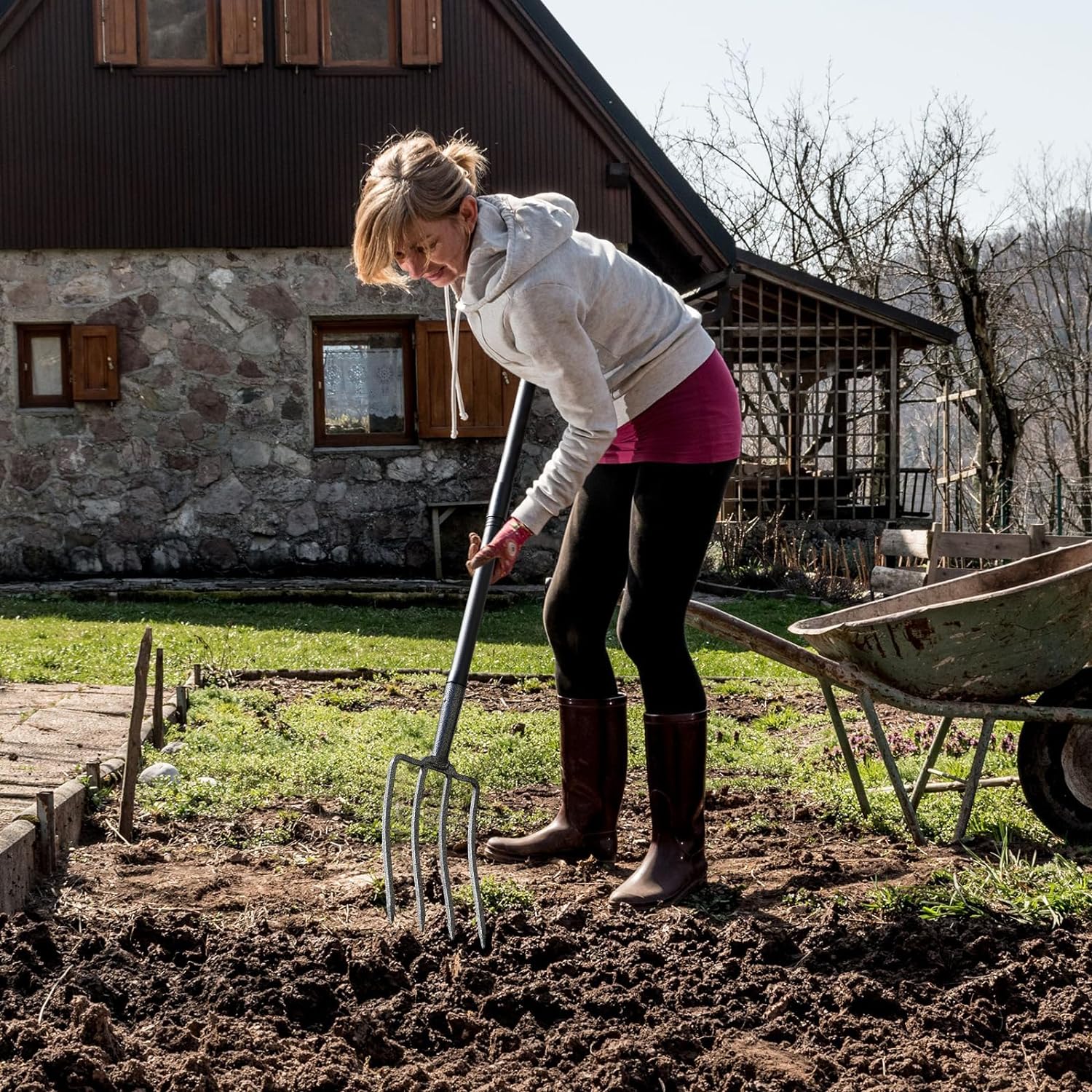
Though not traditionally a garden fork, the pitchfork has found its place in the garden shed. Its long, slender tines are ideal for moving mulch, straw, and other loose materials. It’s a testament to the fact that sometimes, the best tool for the job wasn’t originally designed for gardeners at all.
Getting to the Point: Anatomy of a Garden Fork
Let’s break down what makes a garden fork tick. The anatomy of a garden fork is simple yet crucial to its function. There are tines, a handle, and sometimes a grip. Each part plays a role in how the fork performs and how comfortable it is to use.
Understanding Tine Strength and Spacing
The tines are the business end of a garden fork, and their strength is paramount. Look for forged steel tines that can withstand the pressure of digging into hard soil without bending. The spacing between tines affects how soil is lifted and turned. Closer tines are better for finer soil, while wider tines work well for coarser materials.
Handle With Care: Choosing the Right Handle
The handle is your main point of contact with the fork, so it needs to be comfortable. Handles come in various materials, including wood, metal, and fiberglass. Each has its benefits: wood is warm and traditional, metal is sturdy and long-lasting, and fiberglass is lightweight and reduces fatigue.
Material Matters: Metal vs. Wood vs. Fiberglass
When it comes to the material of the fork itself, you’ve got options:
-
Metal: It’s strong and durable but can be heavy.
-
Wood: It has a classic feel and good shock absorption but may not last as long as metal.
-
Fiberglass: It’s lightweight and resistant to weather, but may not have the same heft as metal for tough jobs.
Therefore, when selecting a garden fork, consider the balance of strength, weight, and longevity that suits your gardening style and needs.
A Step Further: Specialized Forks for Specific Tasks
Just as a chef selects a knife for its intended purpose, gardeners must choose their forks wisely. Different gardening tasks call for specialized forks. Whether you’re harvesting root vegetables or incorporating compost into your garden beds, there’s a fork designed to make your work more efficient and enjoyable.
Rooting Out the Best: Forks for Harvesting Vegetables
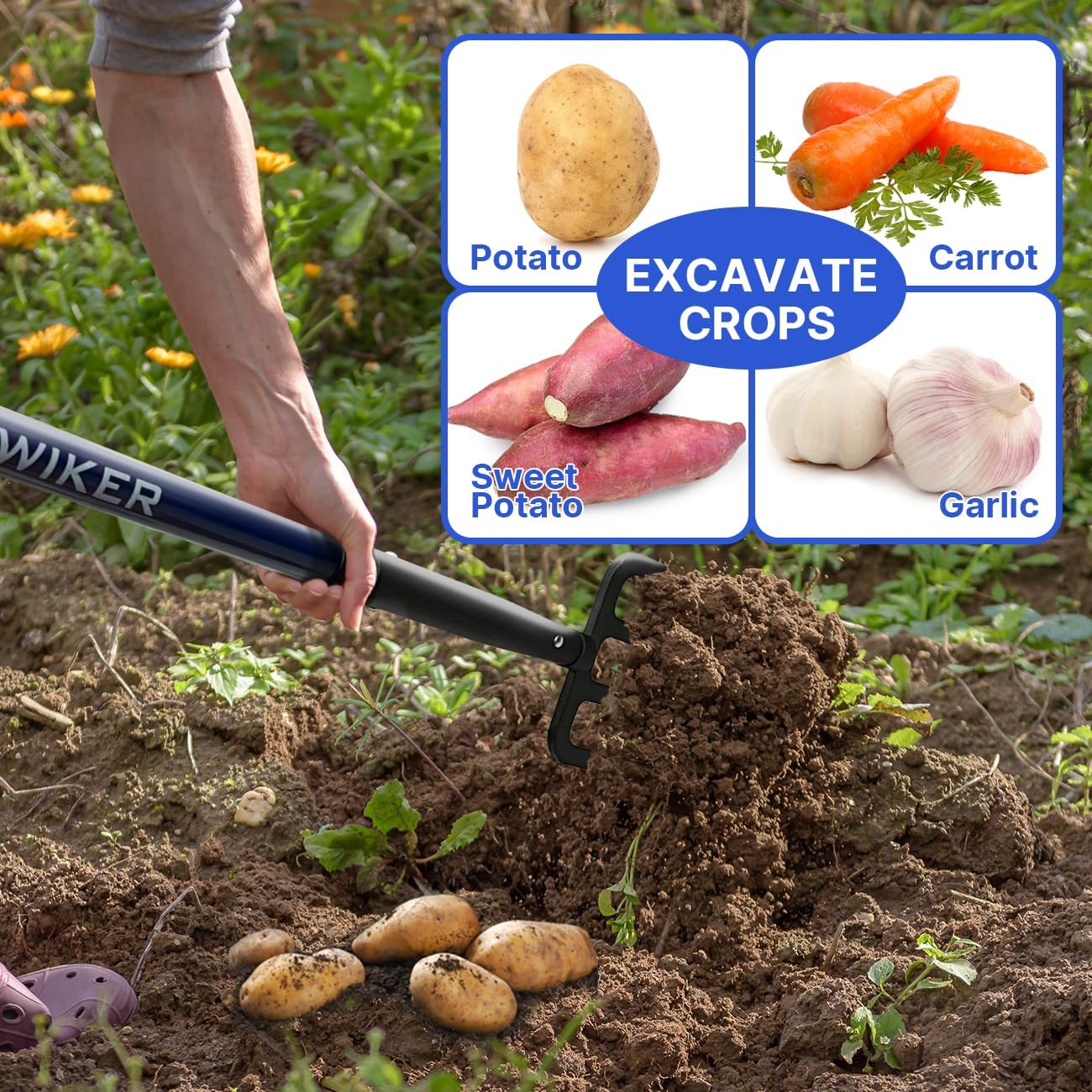
When it’s time to harvest your homegrown veggies, a digging fork is an indispensable tool. Its tines slip into the soil with ease, allowing you to lift carrots, potatoes, and other root crops without damaging them. This is where a fork with broad, flat tines excels, as they can support the vegetables during the lift, preventing breakage.
For example, when you’re pulling up beets, you want to avoid piercing the root, which can lead to premature rotting. A fork with blunt ends is perfect for this task, as it can get under the beet and help you lever it out of the ground without puncturing the vegetable itself.
Remember, the goal is to lift the vegetables, not to stab them. The right fork makes all the difference.
A digging fork also comes in handy when loosening soil around plants for easier harvesting. This is especially true for crops like onions, which can be difficult to pull out by hand when the soil is compacted.
Turning the Soil: Aerating Forks for Healthier Gardens
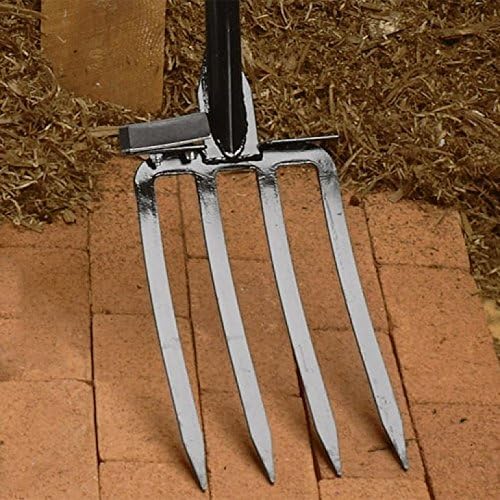
Healthy gardens start with healthy soil, and aerating forks are designed to introduce air and moisture deep into the earth. These forks typically have sharp, narrow tines that penetrate the soil with minimal effort, breaking up clumps and creating space for roots to expand.
Consider this scenario: You’ve just cleared a patch of your garden, and the soil looks compacted. You take your aerating fork and gently work it into the soil, wiggling it back and forth to create air pockets. This simple action can significantly improve the health of your soil, leading to more robust plant growth.
Because aerating the soil is such a critical task, choosing a fork that’s easy to handle and effectively penetrates the ground is important. An aerating fork with a comfortable grip and sturdy tines can transform this chore into a satisfying part of your gardening routine.
The Compact Solution: Hand Forks for Container Gardening
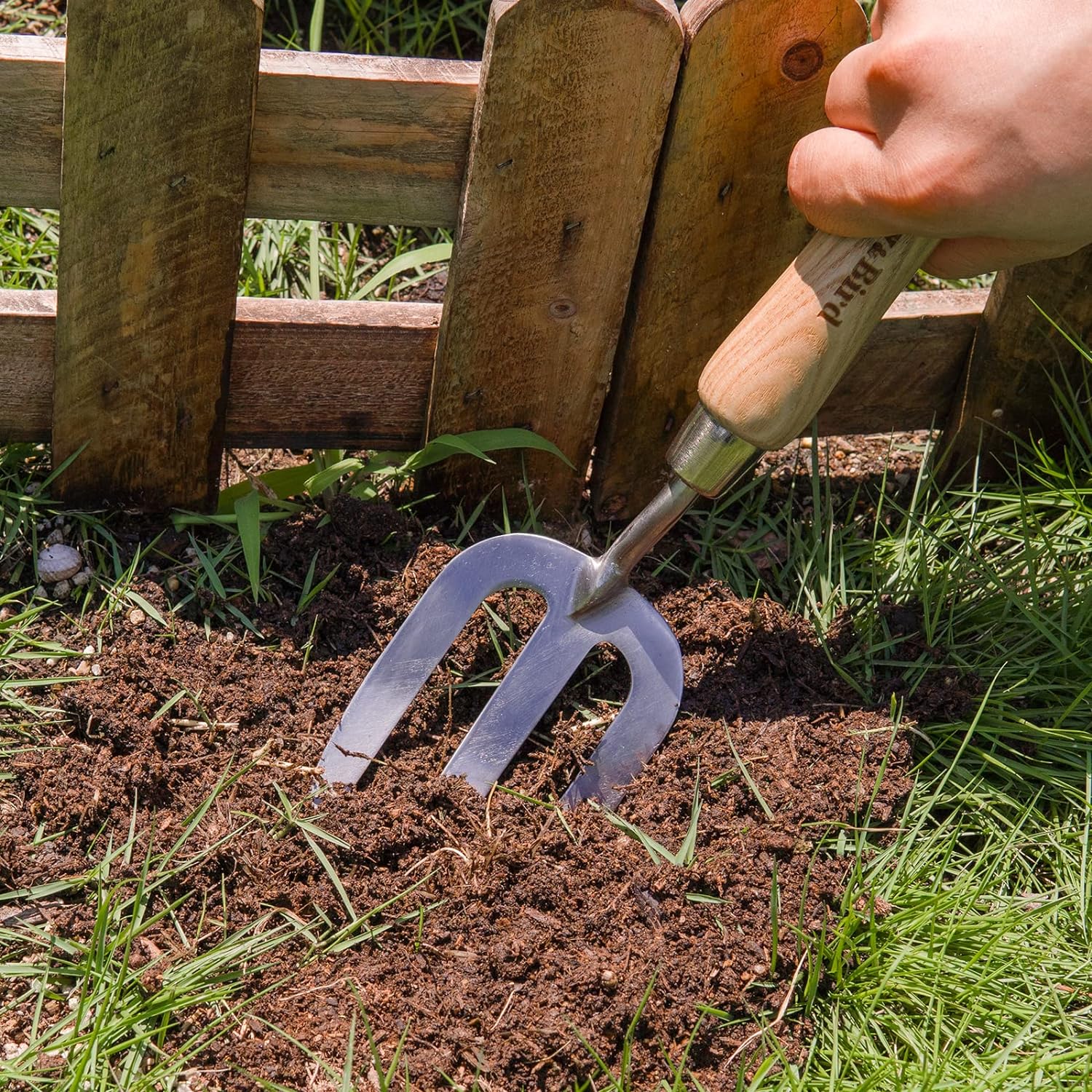
Container gardening is a fantastic way to grow plants in small spaces, and hand forks are the perfect tool for this type of gardening. They’re small, easy to maneuver, and perfect for the delicate work of tending to plants in pots.
Imagine you’re tending to your balcony herb garden. A hand fork allows you to mix in new compost, loosen the soil, and remove any weeds that have sprung up—all without disturbing the roots of your precious herbs.
Choosing the Champion Fork for Your Garden
Now that we’ve explored the different types of forks, how do you choose the champion for your garden? It’s not just about the type of fork; it’s about matching it to your needs, your soil, and your body.
Match the Fork to Your Soil Type
Soil type is a critical factor in selecting a garden fork. If you have heavy, clay-rich soil, you’ll want a fork with strong, sturdy tines that can break through the density. For sandy or loamy soil, a fork with sharper tines will make turning the soil a breeze.
And if you’re working with raised beds or container gardens, a smaller border fork or hand fork may be all you need to keep the soil aerated and your plants happy.
Considering Comfort: Ergonomics and Weight
Gardening shouldn’t be a pain in the back. Ergonomics and weight play a huge role in how comfortable a garden fork is to use. Look for features like padded handles and ergonomically shaped grips that conform to your hand. The weight of the fork is also important; too heavy and you’ll tire quickly, too light and it might not be effective in tougher soil.
Durability and Maintenance: Long-term Garden Success
A garden fork is an investment in your garden’s future. Durability and ease of maintenance are essential for long-term success. Stainless steel tines resist rust and are easy to clean, while a solidly constructed handle will ensure your fork stays intact through the seasons.
Top Fork Picks: Trusted Brands and Products
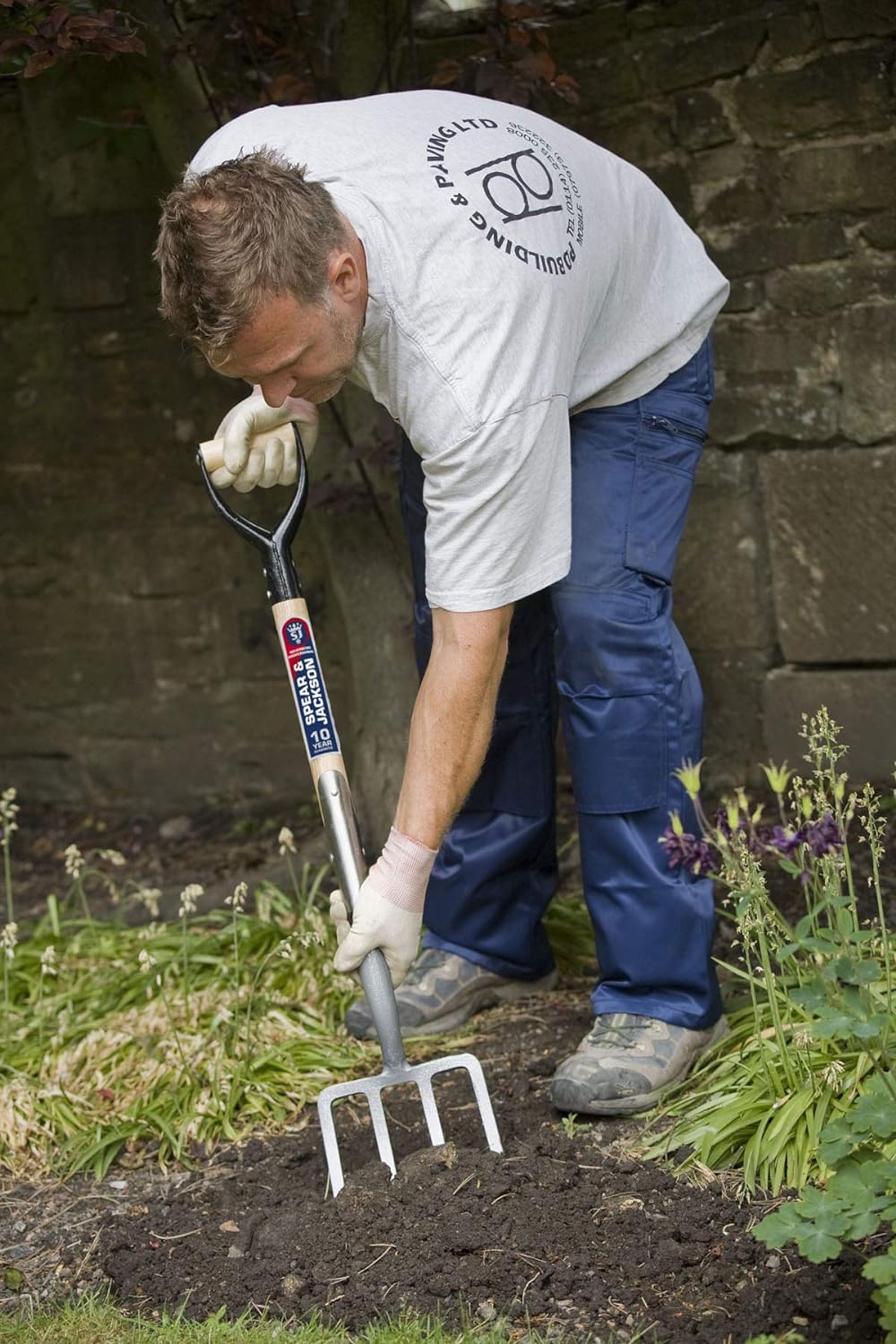
There are many garden forks on the market, but a few brands stand out for their quality and reliability. Let’s take a closer look at some of the top picks that gardeners around the world trust.
The Dependable Spear & Jackson Professional Digging Fork
The Spear & Jackson Professional Digging Fork is a favorite among gardeners for its durability and comfort. This fork features:
-
A solid forged carbon steel head for maximum strength.
-
A weatherproofed hardwood handle that’s both comfortable and long-lasting.
-
A design that exceeds the BS3388 load tests, ensuring it can handle the toughest gardening tasks.
With a 10-year guarantee, the Spear & Jackson fork is a dependable choice for gardeners who want a tool that will last. And it’s not just about the quality; it’s about the peace of mind that comes with knowing you have a reliable tool in your hands.
Spear & Jackson Neverbend Professional Digging Fork – Buy Now on Amazon
For a hassle-free purchase, consider the Spear & Jackson Neverbend Professional Digging Fork available on Amazon. It’s a reliable, well-reviewed option that delivers both quality and durability straight to your door.
Get Your Hands Dirty: Putting Your Garden Fork to Work
Once you’ve chosen your garden fork, it’s time to put it to work. But before you dive in, let’s talk about some essential techniques for efficient digging and tilling that will make your gardening more effective and enjoyable.
Essential Techniques for Efficient Digging and Tilling
Effective digging and tilling are all about technique. Here are some tips to help you get the most out of your garden fork:
-
Start by inserting the fork vertically into the soil. Use your body weight to push it down, rather than your back and arms.
-
Rock the fork back and forth to loosen the soil, then lift and turn it over.
-
When tilling, work in a systematic pattern across your garden bed to ensure even coverage.
With these techniques, you’ll be able to prepare your soil for planting, incorporate organic matter, and improve drainage and aeration, all while reducing physical strain.
Guide to Maintaining Your Garden Fork
To keep your garden fork in tip-top shape, maintenance is key. After each use, remove soil and debris from the tines with a stiff brush. Occasionally, you may need to sharpen the tines with a metal file to maintain their edge, particularly if you frequently work in heavy or clay soil. For wooden handles, a light sanding followed by an application of linseed oil can prevent drying and cracking. Storing your fork in a dry, sheltered area will protect it from the elements and prolong its life. Remember, a well-maintained garden fork is a gardener’s best ally.
Frequently Asked Questions (FAQs)

What is the difference between a digging fork and a spade?
A digging fork is designed with flat, sharp tines for penetrating and turning soil, while a spade typically has a flat, rectangular blade used for cutting edges, digging, and lifting soil. Each tool serves a different purpose in the garden, with the fork being better for aerating soil and the spade for more precise digging.
How do I clean and store my garden fork?
Cleaning your garden fork after each use is crucial. Remove soil with a brush, and occasionally oil wooden handles and sharpen the tines. Store your fork in a dry place to prevent rust and damage. Proper maintenance will extend the life of your fork significantly.
Can I use a border fork for larger garden areas?
While a border fork is smaller and more suited for detailed work around plants, it can be used in larger garden areas if you prefer its lighter weight and maneuverability. However, for extensive work, a larger digging fork may be more efficient.
Are more expensive garden forks worth the investment?
Generally, more expensive garden forks offer better materials and construction, which can lead to improved durability and comfort. Investing in a high-quality fork often means less frequent replacements and a more enjoyable gardening experience.
Is there a warranty on garden forks purchased online?
Many garden forks purchased online come with a manufacturer’s warranty. It’s important to check the product details or contact the seller for warranty information before making your purchase.



